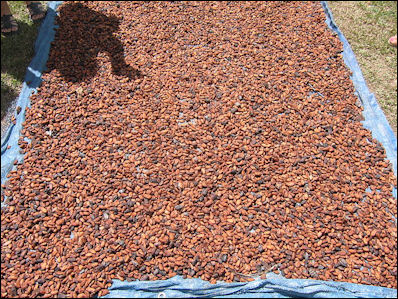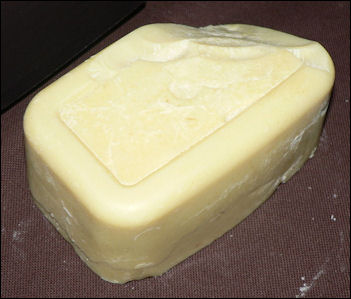CACAO PROCESSING
cacao beans There is no chocolate flavor until the seeds have been fermented. Ground up raw beans taste like dirt. When dry cacao beans are ground up they produce a gooey mess with a surprising amount of liquid. This is mostly fat — unsaturated fat, the kind that’s good for you.
Fresh beans have a mild, bitter, flower-like taste. After they have been harvested they are fermented to mellow their flavor and get rid of the bitterness. This is when they acquire their chocolatey taste and become dark brown in color.
Growers ferment the cacao beans for about five or six days in wooden crates. During fermentation the sugar in the pulp turns to alcohol (the same way sugar in grapes turn to wine). The alcohol then ferments into lactic and acetic acids and causes the cell walls of the bean to breakdown and release the chocolate flavor. Low quality beans are simply left to dry, which causes only partial fermentation and a slightly bitter aftertaste.. The best beans are allowed to completely ferment. After fermentation the beans are dried in the sun so fungus won't grown on them when they are stored or transported.
It takes about two handfuls of dried beans to make one bar of chocolate. How the beans are handled after they are taken from the pods is often a key to their flavor. Beans that dry too fast or are dried with fire often have a smoky flavor while those that haven’t fermented long enough remain bitter and don’t develop a strong chocolate flavor.
Books: “Chocolate: History. Culture and Heritage” edited by Louis Evan Grivetti and Howard-Yana Shapiro (Wiley, 2009); “True History of Chocolate” by Sophie and Michael Coe, food historians (Thames & Hudson); “Chocolate: A Bittersweet Saga of Dark and Light” by Mort Rosenblum (North Point Press)
Websites and Resources: All About Chocolate fieldmuseum.org ; Encyclopedia of Life Cacao Plant eol.org/pages/484592 ; Chocolate and the Maya authenticmaya.com ; Chocolate Food of the Gods site exhibits.mannlib.cornell.edu/chocolate ; Cacao Tree hort.purdue.edu/newcrop/duke_energy/Theobroma_cacao ; International Cocoa Organization (ICCO): www.icco.org/ ; Wikipedia article Wikipedia ; Food of the Gods e-book gutenberg.org/ebooks ; Cadbury Chocolate: cadbury.co.uk ; Hersey making Chocolate hersheys.com/discover/ ; Production of Chocolate sfu.ca/geog
World’s Top Cocoa Bean Importing Countries
drying the cacao beans
World’s Top Importers of Cocoa Beans (2020): 1) Netherlands: 987900 tonnes; 2) Germany: 441883 tonnes; 3) Malaysia: 384682 tonnes; 4) United States: 377074 tonnes; 5) Belgium: 279495 tonnes; 6) Indonesia: 198838 tonnes; 7) France: 159488 tonnes; 8) Turkey: 137470 tonnes; 9) United Kingdom: 116462 tonnes; 10) Canada: 104470 tonnes; 11) Italy: 99550 tonnes; 12) Spain: 97535 tonnes; 13) Singapore: 85392 tonnes; 14) Russia: 69910 tonnes; 15) Switzerland: 48670 tonnes; 16) Japan: 48533 tonnes; 17) Brazil: 46488 tonnes; 18) Austria: 26591 tonnes; 19) India: 22993 tonnes; 20) China: 20293 tonnes. [Source: FAOSTAT, Food and Agriculture Organization (U.N.), fao.org]
World’s Top Importers (in value terms) of Cocoa Beans (2020): 1) Netherlands: US$2635302,000; 2) Germany: US$1211717,000; 3) United States: US$1026931,000; 4) Malaysia: US$972390,000; 5) Belgium: US$791833,000; 6) Indonesia: US$505495,000; 7) France: US$457443,000; 8) Turkey: US$341020,000; 9) United Kingdom: US$313086,000; 10) Italy: US$301716,000; 11) Spain: US$261532,000; 12) Canada: US$259331,000; 13) Singapore: US$227759,000; 14) Russia: US$210573,000; 15) Switzerland: US$139808,000; 16) Japan: US$137168,000; 17) Brazil: US$123841,000; 18) Austria: US$73812,000; 19) India: US$60369,000; 20) China: US$52968,000
Cacao Fermentation
Describing a shack used for the fermentation of a ton of cacao Bill Buford wrote in The New Yorker, “Inside, the room was shadowy and hot. The smells multiplied instantly, a sudden olfactory cargo: a brewery, but also a winery, a vinegar factory, a dairy. ...There was a gas, mildly disconcerting. It singed the lungs but felt strangely pleasant...One trough was full. The beans, about chest-high, were covered with banana leaves, a gently heaving green blanket. Wrapped tight, an oven on high. The yeast plus sugar produced carbon dioxide, plus heat and alcohol. There was plenty of yeast on the banana leaves, a rich source...Badero pulled back some leaves. The beans instantly released a more intense hit of everything we’d been smelling. It was alcoholic and vaporous.”
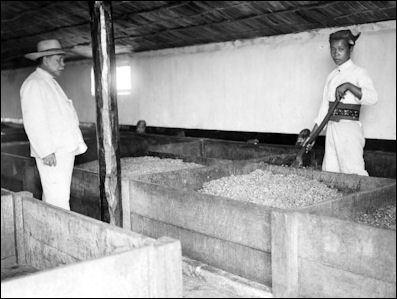
Cacao fermentation in colonial Java “They were in the third day of fermentation, and were now purply, the sweet pulp almost entirely gone, although still gooey. ..the full trough was separated from other empty ones by wooden slats. Badero removed one so that he could shovel beans into the next space. No matter how tightly everything was wrapped, the beans on top were cooler than the ones at the bottom. By shoveling everything next door, Badaro was turning them over...With cacao, an infantry of yeast converge in the pulp around the seed and convert it into alcohol...the liquids drain away, the alcohol evaporates...the seed is heated to temperature rarely seen in the natural world. The shell is savaged and penetrated, until the tissue inside is invaded.”
“At the end, the bean is the equivalent of the grapey mash” in wine production. “It has been reduced in size. It smells powerfully of vinegar. Its proteins have been disfigured. If you open one up, its insides look a though they’d been obliterated. In the devastation, the extreme intensities of cacao are converted to flavors.”
Chocolate Processing
Chocolate is made with beans that have been cleaned, roasted, crushed, shelled and winnowed. This is often done at foreign plants. In a huge cleaner, the beans are separated from their accompanying debris by huge blowers. Then they are roasted in another machine. The winnower separates the beans from the shells, with the beans falling from side and the shells sliding out one side the other.
The resulting “nibs” (hulled pieces of dried or roasted beans) or meat of the bean are ground and heated until a thick paste called chocolate liquor is formed. Cacao nibs have a strong chocolatey flavor when sucked or chewed. Some people consider them too bitter and too gritty to consume while other people find their flavor to be “marvelously deep and powerful."
Cocoa butter The liquor is combined with coca butter, sugar, milk and vanilla and is "conched" — rolled over and over against itself like pebbles in the sea — in enormous circular machine that resemble a conch shell. Conching adds smoothness and creaminess and can be done anywhere from a few hours to a few days. Afterwards it is poured into molds for bars or wafers. Hardened chocolate liquor, which has no alcohol by the way, become bakers chocolate. Chocolate is difficult to mix with milk because of the intolerance of the fats to mix with anything with water in it.
Describing the making of chocolate, Kate Singleton wrote in the New York Times: "The crude chocolate is heated to around 40 to 50 degrees. When the cocoa butter melts the basic ingredients can be worked together with vanilla and sugar until it is ready to be placed in rectangular aluminum forms that give the sturdy little bars of chocolate their shape. Before the chocolate solidifies, these forms are lined up on a large wooden tray that is beaten relentlessly against the thick pale gray marble kitchen top." The last steps gets ride of air bubbles, which leaves the bars shiny and smooth.
Fermentation, roasting and conching all influence the flavor of chocolate. Small variations in the amount of sugar and cocoa butter, roasting temperature can also make a big difference in the flavor of the chocolate. Too high of a roasting temperature, for example, can ruin the delicate flavor of the best beans and make even mild beans have a bitter flavor.
Cacao Butter Processing
If chocolate liquor is subjected to high pressure, cocoa butter is squeezed out and cacao powder is left behind. Chocolate powder is essentially hot cocoa mix without sugar. Cocoa butter makes chocolate rich and creamy and what gives it that melt-in-your-mouth quality.
Cacao butter is the world's most expensive natural fat. It has a melting point of 90̊F, which is why chocolate doesn't melt at room temperature but melts in your hand or on hot days when temperatures rise above 95 F. Chocolate candy is rare in tropical countries with few refrigerators. Additives that help keep chocolate hard in hot climates compromise its creaminess.
Cacao butter is what gives fine chocolate its silky texture. The best chocolates often have high concentrations of it, Bars made by Nestle and Mars have relatively small amounts of cocoa butter but large amounts of sorbitol, a sweetener that extends their shelf life.
World’s Top Cocoa Butter Exporting and Importing Countries
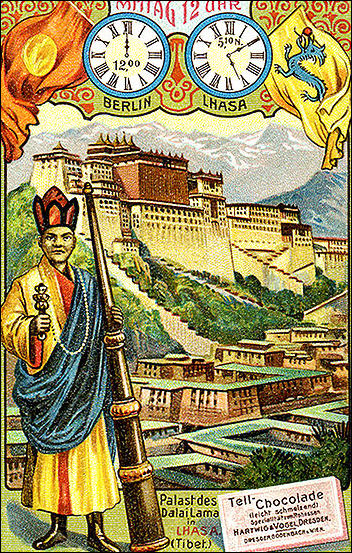
chocolate poster with the Dalai LamaWorld’s Top Exporters of Cocoa Butter (2020): 1) Netherlands: 256160 tonnes; 2) Indonesia: 144490 tonnes; 3) Malaysia: 110103 tonnes; 4) Côte d'Ivoire: 86492 tonnes; 5) Germany: 76085 tonnes; 6) France: 73248 tonnes; 7) Ghana: 55441 tonnes; 8) Singapore: 28899 tonnes; 9) Brazil: 23764 tonnes; 10) United States: 20236 tonnes; 11) Cameroon: 19263 tonnes; 12) Belgium: 17792 tonnes; 13) Peru: 11999 tonnes; 14) Nigeria: 10170 tonnes; 15) Canada: 9577 tonnes; 16) India: 9306 tonnes; 17) Spain: 8153 tonnes; 18) United Kingdom: 7077 tonnes; 19) China: 5701 tonnes; 20) Colombia: 4682 tonnes. [Source: FAOSTAT, Food and Agriculture Organization (U.N.), fao.org]
World’s Top Exporters (in value terms) of Cocoa Butter (2020): 1) Netherlands: US$1553006,000; 2) Indonesia: US$790990,000; 3) Malaysia: US$599333,000; 4) Germany: US$462189,000; 5) France: US$453605,000; 6) Côte d'Ivoire: US$438637,000; 7) Ghana: US$291444,000; 8) Singapore: US$173433,000; 9) Brazil: US$133048,000; 10) Belgium: US$105264,000; 11) Cameroon: US$98127,000; 12) United States: US$96019,000; 13) Peru: US$65913,000; 14) Canada: US$62646,000; 15) Spain: US$48113,000; 16) Nigeria: US$46103,000; 17) India: US$42267,000; 18) United Kingdom: US$41442,000; 19) China: US$29345,000; 20) Italy: US$26697,000
World’s Top Importers of Cocoa Butter (2020): 1) Germany: 152100 tonnes; 2) Belgium: 114785 tonnes; 3) United States: 98227 tonnes; 4) Netherlands: 86003 tonnes; 5) France: 77832 tonnes; 6) United Kingdom: 56367 tonnes; 7) Poland: 45020 tonnes; 8) Italy: 36851 tonnes; 9) Russia: 35025 tonnes; 10) Canada: 28255 tonnes; 11) Switzerland: 25950 tonnes; 12) Japan: 21576 tonnes; 13) Australia: 19736 tonnes; 14) Turkey: 15012 tonnes; 15) China: 12962 tonnes; 16) Ukraine: 9991 tonnes; 17) India: 9677 tonnes; 18) Malaysia: 9588 tonnes; 19) Spain: 8566 tonnes; 20) Argentina: 8346 tonnes. [Source: FAOSTAT, Food and Agriculture Organization (U.N.), fao.org]
World’s Top Importers (in value terms) of Cocoa Butter (2020): 1) Germany: US$883343,000; 2) Belgium: US$686070,000; 3) United States: US$573884,000; 4) Netherlands: US$480259,000; 5) France: US$435597,000; 6) United Kingdom: US$321365,000; 7) Poland: US$273276,000; 8) Italy: US$236805,000; 9) Russia: US$207182,000; 10) Canada: US$176508,000; 11) Switzerland: US$157081,000; 12) Japan: US$123514,000; 13) Australia: US$112919,000; 14) Turkey: US$86385,000; 15) China: US$76015,000; 16) Ukraine: US$59723,000; 17) India: US$55776,000; 18) Sweden: US$48172,000; 19) Argentina: US$47195,000; 20) Spain: US$47039,000
World’s Top Cocoa Paste Exporting and Importing Countries
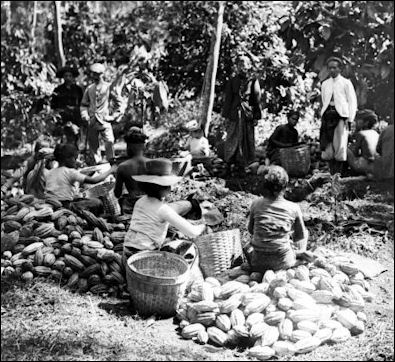
Cacao in colonial Indonesia World’s Top Exporters of Cocoa Paste (2020): 1) Côte d'Ivoire: 256848 tonnes; 2) Netherlands: 183075 tonnes; 3) Ghana: 108199 tonnes; 4) Germany: 72962 tonnes; 5) France: 47346 tonnes; 6) Malaysia: 20918 tonnes; 7) Ecuador: 20167 tonnes; 8) Switzerland: 18214 tonnes; 9) Belgium: 17203 tonnes; 10) United States: 15413 tonnes; 11) United Kingdom: 13484 tonnes; 12) Bulgaria: 13333 tonnes; 13) Poland: 13086 tonnes; 14) Indonesia: 10976 tonnes; 15) Ukraine: 10136 tonnes; 16) Cameroon: 7196 tonnes; 17) Canada: 7160 tonnes; 18) Spain: 6240 tonnes; 19) Nigeria: 5480 tonnes; 20) Slovakia: 5471 tonnes. [Source: FAOSTAT, Food and Agriculture Organization (U.N.), fao.org]
World’s Top Exporters (in value terms) of Cocoa Paste (2020): 1) Cote d’Ivoire: US$817598,000; 2) Netherlands: US$661586,000; 3) Ghana: US$333127,000; 4) Germany: US$271562,000; 5) France: US$185635,000; 6) Malaysia: US$85936,000; 7) Switzerland: US$82063,000; 8) Belgium: US$76588,000; 9) Ecuador: US$72393,000; 10) United States: US$58897,000; 11) United Kingdom: US$53921,000; 12) Indonesia: US$52273,000; 13) Poland: US$51684,000; 14) Bulgaria: US$46727,000; 15) Ukraine: US$41586,000; 16) Canada: US$30662,000; 17) Cameroon: US$24032,000; 18) Spain: US$23157,000; 19) Slovakia: US$22054,000; 20) Brazil: US$19811,000
World’s Top Importers of Cocoa Paste (2020): 1) Netherlands: 130759 tonnes; 2) France: 110347 tonnes; 3) Belgium: 85128 tonnes; 4) United States: 77944 tonnes; 5) Germany: 75194 tonnes; 6) Poland: 56036 tonnes; 7) Russia: 36742 tonnes; 8) Canada: 26942 tonnes; 9) Italy: 26824 tonnes; 10) Turkey: 23663 tonnes; 11) Australia: 17110 tonnes; 12) China: 15170 tonnes; 13) United Kingdom: 14288 tonnes; 14) Ukraine: 13293 tonnes; 15) Singapore: 13075 tonnes; 16) Japan: 12373 tonnes; 17) Spain: 12047 tonnes; 18) Switzerland: 8926 tonnes; 19) Bulgaria: 8272 tonnes; 20) Argentina: 7382 tonnes. [Source: FAOSTAT, Food and Agriculture Organization (U.N.), fao.org]
World’s Top Importers (in value terms) of Cocoa Paste (2020): 1) Netherlands: US$442432,000; 2) Belgium: US$320995,000; 3) France: US$314487,000; 4) United States: US$311185,000; 5) Germany: US$283089,000; 6) Poland: US$205107,000; 7) Russia: US$139190,000; 8) Italy: US$107423,000; 9) Canada: US$101673,000; 10) Turkey: US$84597,000; 11) Australia: US$73425,000; 12) China: US$68495,000; 13) United Kingdom: US$53776,000; 14) Singapore: US$49824,000; 15) Japan: US$48424,000; 16) Ukraine: US$45425,000; 17) Spain: US$42430,000; 18) Switzerland: US$38906,000; 19) Bulgaria: US$30134,000; 20) Argentina: US$28014,000
World’s Top Cocoa Powder and Cake Exporting and Importing Countries
World’s Top Exporters of Cocoa Powder and Cake (2020): 1) Netherlands: 295646 tonnes; 2) Indonesia: 162854 tonnes; 3) Malaysia: 152625 tonnes; 4) Côte d'Ivoire: 148088 tonnes; 5) Germany: 114875 tonnes; 6) Ghana: 90566 tonnes; 7) Spain: 77976 tonnes; 8) France: 46772 tonnes; 9) Singapore: 44684 tonnes; 10) United States: 34232 tonnes; 11) Turkey: 20836 tonnes; 12) Brazil: 20750 tonnes; 13) Cameroon: 19090 tonnes; 14) China: 15590 tonnes; 15) Italy: 10766 tonnes; 16) Peru: 9082 tonnes; 17) Uruguay: 7878 tonnes; 18) Canada: 6512 tonnes; 19) Belgium: 6106 tonnes; 20) Bulgaria: 6049 tonnes. [Source: FAOSTAT, Food and Agriculture Organization (U.N.), fao.org]

chocolate factory machines in a museum
World’s Top Exporters (in value terms) of Cocoa Powder and Cake (2020): 1) Netherlands: US$737622,000; 2) Malaysia: US$307313,000; 3) Germany: US$285501,000; 4) Indonesia: US$279452,000; 5) Cote d’Ivoire: US$252434,000; 6) Spain: US$166841,000; 7) France: US$146992,000; 8) Ghana: US$146126,000; 9) Singapore: US$116685,000; 10) United States: US$99551,000; 11) Turkey: US$52722,000; 12) Brazil: US$50430,000; 13) Cameroon: US$33817,000; 14) Italy: US$29221,000; 15) Belgium: US$23596,000; 16) China: US$23161,000; 17) Peru: US$23079,000; 18) Canada: US$19651,000; 19) Uruguay: US$14558,000; 20) Austria: US$13092,000
World’s Top Importers of Cocoa Powder and Cake (2020): 1) United States: 154257 tonnes; 2) Spain: 87496 tonnes; 3) Netherlands: 81220 tonnes; 4) Germany: 66495 tonnes; 5) Russia: 57370 tonnes; 6) China: 46354 tonnes; 7) France: 43896 tonnes; 8) Turkey: 40577 tonnes; 9) Brazil: 38524 tonnes; 10) Italy: 37458 tonnes; 11) Malaysia: 36219 tonnes; 12) India: 29322 tonnes; 13) Indonesia: 29006 tonnes; 14) Philippines: 27548 tonnes; 15) Poland: 27357 tonnes; 16) Belgium: 27347 tonnes; 17) Canada: 25047 tonnes; 18) Egypt: 23586 tonnes; 19) Thailand: 19439 tonnes; 20) Japan: 18629 tonnes. [Source: FAOSTAT, Food and Agriculture Organization (U.N.), fao.org]
World’s Top Importers (in value terms) of Cocoa Powder and Cake (2020): 1) United States: US$389534,000; 2) Netherlands: US$176478,000; 3) Germany: US$160907,000; 4) Spain: US$137338,000; 5) Russia: US$117985,000; 6) France: US$115184,000; 7) China: US$103719,000; 8) Italy: US$98494,000; 9) Turkey: US$88602,000; 10) Belgium: US$77488,000; 11) Brazil: US$76069,000; 12) Canada: US$70431,000; 13) Poland: US$67588,000; 14) Indonesia: US$63909,000; 15) Malaysia: US$62917,000; 16) Philippines: US$59535,000; 17) Japan: US$59434,000; 18) India: US$58297,000; 19) Mexico: US$50172,000; 20) Egypt: US$49496,000
Chocolate Products
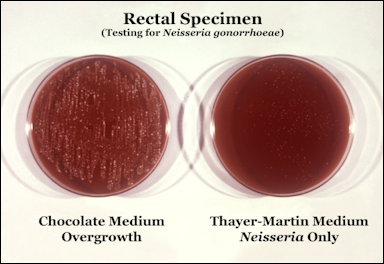
chocolate research Products made from chocolate include cocoa drink, milk chocolate bars, truffles, bonbons (filled chocolates, known as "pralines" in Europe).
As is the case with coffee, most chocolates are made with blends of cacao beans with small amounts of premium "flavor" beans providing most of the flavor and cheaper industrial-grade beans making up most of the bulk. Candy markers often times substitute vegetable oils, which are much cheaper, for cocoa butter, and the result is not chocolate but "confectionery coating," which is found enveloping Baby Ruths and many other candy bars.
A modern milk chocolate bar is only 40 percent chocolate, White chocolate is produced from a mixture of cocoa butter, sugar, milk and flavoring, but no chocolate liquor, True chocolate connoisseurs do not consider white chocolate to be real chocolate because its essentially just cocoa butter and sugar.
Cacao and chocolate contain hundreds of substances and about 40 or 50 of them are considered critical for chocolate's taste, but no one is quite sure which ones they are, let alone manufacture them. Thus far efforts to produce a synthetic chocolate have largely been unsuccessful.
Chocolate is sometimes uses as a building material. A Barcelona confectionery built a chocolate replica of the Statue of Liberty in 1984; and a psychiatrists in Massachusetts lives in chocolate house imported from Holland in 1894. At the World Columbian Exposition in 1893, the Stollerck company produced a 38-foot-high Renaissance temple made from chocolate.
During a slump in chocolate sales producers are experimenting with cocoa butter soap, soft drinks, jam, jelly, vinegars, fertilizer and brandy produced by sweating cocoa beans (the juice that trickles out as the beans lie in heaps on the ground covered by banana leaves). Chocolate perfume are already on the market. and go on chocolate cruises.
World’s Top Exporting and Importing Countries of Chocolate Products

Chocolate cubes with coffee beans World’s Top Exporters of Chocolate Products nes (2020): 1) Germany: 906312 tonnes; 2) Belgium: 651393 tonnes; 3) Netherlands: 413557 tonnes; 4) Poland: 410607 tonnes; 5) Canada: 395048 tonnes; 6) Italy: 342230 tonnes; 7) France: 304984 tonnes; 8) Russia: 295573 tonnes; 9) United States: 277663 tonnes; 10) Turkey: 197045 tonnes; 11) Mexico: 196953 tonnes; 12) United Kingdom: 188749 tonnes; 13) Spain: 115017 tonnes; 14) Switzerland: 109742 tonnes; 15) Austria: 108964 tonnes; 16) Singapore: 108091 tonnes; 17) United Arab Emirates: 84955 tonnes; 18) Sweden: 75272 tonnes; 19) Malaysia: 72765 tonnes; 20) Ireland: 67480 tonnes. [Source: FAOSTAT, Food and Agriculture Organization (U.N.), fao.org, nes means “Not elsewhere specified or included”]
World’s Top Exporters (in value terms) of Chocolate Products nes (2020): 1) Germany: US$4861710,000; 2) Belgium: US$3137347,000; 3) Italy: US$2089742,000; 4) Poland: US$2076184,000; 5) Netherlands: US$1851112,000; 6) Canada: US$1615892,000; 7) United States: US$1390101,000; 8) France: US$1301221,000; 9) United Kingdom: US$1010393,000; 10) Switzerland: US$751475,000; 11) Russia: US$729156,000; 12) Mexico: US$604353,000; 13) Turkey: US$552663,000; 14) Spain: US$468916,000; 15) Austria: US$456739,000; 16) Singapore: US$443478,000; 17) United Arab Emirates: US$437420,000; 18) Sweden: US$391695,000; 19) Ireland: US$347812,000; 20) Czechia: US$310107,000
World’s Top Importers of Chocolate Products nes (2020): 1) United States: 637897 tonnes; 2) United Kingdom: 494930 tonnes; 3) Germany: 486284 tonnes; 4) France: 464197 tonnes; 5) Netherlands: 282672 tonnes; 6) Belgium: 260190 tonnes; 7) Poland: 224367 tonnes; 8) Canada: 207266 tonnes; 9) Japan: 167362 tonnes; 10) Spain: 141190 tonnes; 11) Russia: 126262 tonnes; 12) Italy: 121972 tonnes; 13) China: 108158 tonnes; 14) United Arab Emirates: 93809 tonnes; 15) Ireland: 89517 tonnes; 16) Saudi Arabia: 87779 tonnes; 17) Austria: 87125 tonnes; 18) Romania: 86876 tonnes; 19) Czechia: 83901 tonnes; 20) Sweden: 80331 tonnes. [Source: FAOSTAT, Food and Agriculture Organization (U.N.), fao.org, nes means “Not elsewhere specified or included”]
World’s Top Importers (in value terms) of Chocolate Products nes (2020): 1) United States: US$2887644,000; 2) Germany: US$2403691,000; 3) United Kingdom: US$2264482,000; 4) France: US$2203500,000; 5) Netherlands: US$1362542,000; 6) Belgium: US$1066954,000; 7) Canada: US$1018533,000; 8) Poland: US$941593,000; 9) Spain: US$616017,000; 10) Italy: US$614836,000; 11) Japan: US$578489,000; 12) Russia: US$546350,000; 13) United Arab Emirates: US$493980,000; 14) Austria: US$486021,000; 15) China: US$473846,000; 16) Australia: US$466657,000; 17) Sweden: US$419979,000; 18) Saudi Arabia: US$419025,000; 19) Ireland: US$409392,000; 20) Czechia: US$397111,000
High-Quality Chocolates
chocolatierHigh end chocolates invariably come as bars. Anything less — a truffle or a nougat — is regarded as frivolous, wrote Buford. Their makers regard themselves with same seriousness as the makers of fine wines, the wrappers of bars are often like little encyclopedias, carefully explaining the ingredients and where the beans come from. Some bars have the harvest years like vintage wines. Sometimes the word “crus” used to name after a specific farm, a term that originated in one of the best wine-growing areas of Bordeaux.
There is an increasing demand for fine, dark single-origin (unblended with other varieties) chocolate. The most important determinate of a fine chocolate here is cacao content with 70 percent generally regarded as the benchmark for a quality product. The figure is a measure of “cocoa” mass, the mass after the beans are ground. The first 70-percent bar was released in 1986 by Valrhona (See Below). Before that most dark chocolate was half sugar, and regarded as a bittersweet confection.
Chocolate makers sell their products with the cacao content printed on the wrappers. Chocolates with a high cacao content rarely spoil and remain fresh years after they have been made.
In recent years a number of chocolate producers have introduced expensive “varietal” products that they hope will sell like fine wines or specialty coffees. Like the designer chocolates above most are dark and lightly sweetened. Some companies even make chocolates classified by vintage (with beans picked the same year) and "estates” (with beans from the same place).
The Wine Spectator has begun running chocolate reviews in which dark chocolates are described with terms like "powerful body," "a slightly puckish finish," “astringent with some floral notes,” and "oak overtones." One reviewer called a Venezuelan chocolate “silky and smooth with hints of black and red fruits.” A Sumatran-bean chocolate was said to have a “nice balance of cream, earth and fruit, though finishes a bit short.” Varieties from Ghana, Trinidad and Ecuador has been described respectively as “long-lasting....peppered with spicy peaks and only a hint of vanilla,” “redolent of smoky, dried, herbs and blond tobacco” and with “hints of figs and candied citrus, rich on the tongue.”
Porcelana from South America is one of the rarest varieties. It is sold by the Italian company Amedai for $270 a kilogram. Chocolate from the Chuao valley beans of Venezuela, Ocumares and Madagascars are also highly sought after.
Designer Chocolates
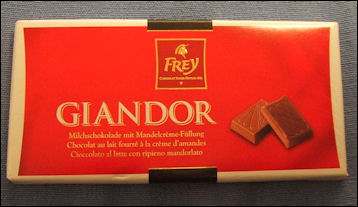
Expensive designer chocolate makers include Valrhona of France's Rhone Valley, Michel Cluizel of France and El Rey from Venezuela.. Guittard Chocolate, Tcho, Scharffen Berger and Tcho from the United States are relative newcomers.
El Rey was founded in 1929. It offers nine bars. Michel Cluizel is a family-run chocolate company with each division headed by one Cluizel’s offspring.
Valrhona was founded in 1924 and sells ten basic bars. It is named after the Caribbean island where chocolate was first seen by Europeans (on Columbus’s last voyage). The Valrhona Guanja was the first 70-percent cacao bar. It was released in 1986 after two years of secret testing by pastry chefs and repeated testings by a Valrhona jury. The Gran Couva bar is made from beans grown on one company-owned estate in Trinidad, where the whole chocolate-making process is controlled from beginning to end.
Scharffen Berger is based in Berkeley, California. It sells six bars. Tcho, founded by a former NASA software developer, uses wine descriptions like “fruity,” “nutty” and “floral” to describe its products. Hershey bought organic chocolatier Dagoba and chocolate artisans Scharffen Berger and Joseph Schmidt.
Top of the line chocolate bars, which sell for between $5 and $14, include Tcho, Amano and Cladio Coralla. Among the gourmet bars that sell for $3 to $4 and have things like rose hips and bacon in them are organic Dagoba bars and Theo bars. Scharffen Berger extra Dark has a cacao content of 82 percent.
Chocolate Rules, Regulations and Spies

Chocolate spread
Chocolate fudge cake Swiss candy makers are required by law to use Swiss raw materials. Foreign companies have no such restrictions and, as journalist Gordon Young said, this opened the country up to "an invasion from Mars." In the 1960s the makers of Milky Ways and M&M's landed in Switzerland with cheaper candy products and before the Swiss realized what was happening the American company had captured a large portion of the children's candy market. The Swiss chocolate companies for their part have had great success expanding into new markets in Turkey and Saudi Arabia.
In the U.S. and most countries in Europe insists that real chocolate must made entirely with cocoa butter. Some European countries allow candy manufactures to replace 5 percent of the cocoa butter with cheaper vegetable oil. A big issue in the European Union is whether of not chocolate-like candy made with palm oil can be labeled as chocolate or must include the words "vegetable fat" alongside the product name.
In the mid 2000s, Hershey replaced cocoa butter with vegetable oil in several products, which is why the labels of Mr. Goodbar, Milk Duds and Krackle say things like “chocolatey” rather than “milk chocolate.”
Sometimes there is even espionage in the chocolate industry. In the 1980s an employee of a Swiss Candy producer photographed some recipes and tried to sell them to the Russians, Chinese and Saudi Arabians. In the early 2000s, a major figure in the Venezuelan chocolate trade was gunned down in his own car.
World Chocolate Consumers
Belgium, Norway, Switzerland and the United Kingdom are the four major chocolate consuming nations in the world. Each person in these countries on average eats over 16 pounds of chocolate every year. The Swiss hold the number one position with a per capita consumption rate of 22 pounds.
Americans buy about $12 billion worth of chocolate a year. Hershey and Mars claim about two thirds of the U.S. chocolate market. About a quarter of all chocolate sales are in dark chocolate. This sector is expected to grow to $5½ billion by 2011.
Per Capita chocolate consumption between 1990 and 1994: Germany (7.1 pounds); Britain (6.83 pounds); France (5.97 pounds); the United States (4.94 pounds); Japan (1.98 pounds). [Source: New York Times, LMC International, International Cocoa Organization]
In 2010, students from England’s University of Warwick powered a Formula 3 race car with fuel made from leftover chocolate. The vehicle, which was displayed the Massachusetts Institute of Technology, was capable of going from zero to 60 kph in 2.5 seconds and reaching speeds of 215 kph. It had a BMW engine converted to run on diesel made from chocolate factory waste.
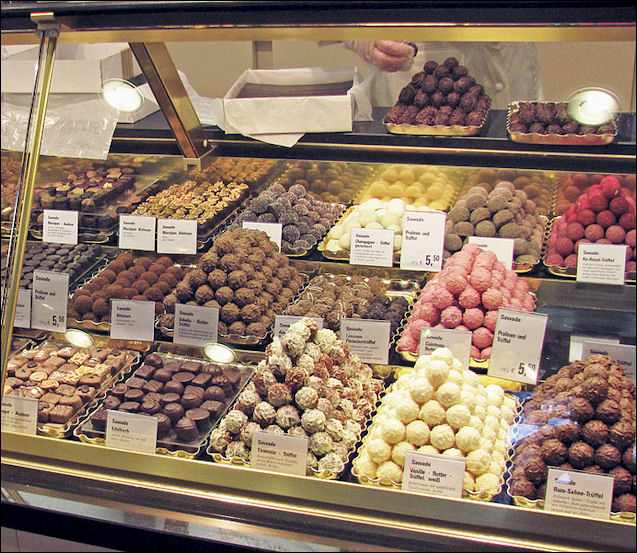
Chocolate in KaDeWe department store in Germany
Image Sources: Wikimedia Commons
Text Sources: National Geographic, New York Times, Washington Post, Los Angeles Times, Smithsonian magazine, Natural History magazine, Discover magazine, Times of London, The New Yorker, Time, Newsweek, Reuters, AP, AFP, Lonely Planet Guides, Compton’s Encyclopedia and various books and other publications.
Last updated March 2022


